We all want a shredded oblique to get a V-shaped bench-ready body. Oblique muscles, also known as “love handles,” are visible when someone has excess fat on the sides of their body.
Obliques are an important part of your entire core that is useful during rotational exercises and balancing your way through everyday life.
These often-overlooked muscles provide stability, improve posture, enhance athletic performance, and reduce the risk of back pain.
Whatever you want, I will provide a complete guide and the best exercises for training your oblique at home or the gym.

- Know About Obliques Muscles
- External Oblique
- Internal Oblique
- Transversus Abdominis
- How To Train Oblique Muscles
- 1. Focus on Specific Oblique Exercises
- 2. Add Rotational Exercises
- 3. Do Functional Movements
- 4. Core Stability Training
- 5. Progressive Overload
- 6. Do Cardiovascular Exercise
- Best Oblique Exercises For Beginners to Advance
- 1. Oblique Crunch
- 2. Dumbbell Side Bend
- 3. Cable Side Bend
- 4. Hanging Windshield Wiper
- 5. Side Plank
- 6. Twisting Sit-Up
- 7. Bicycle Crunch
- 8. Russian Twist
- 9. Landmine Twists
- 10. Side Plank with Hip Abduction
- 11. Side Jackknife
- 12. Lying Bent-Knee Oblique Twist
- 13. Alternate Heel Touches
- 14. Pallof Press
- 15. Cable Wood Chop
- 16. Cable Down-Up Twist
- 17. Cable Twist
- 18. Cross-Body Mountain Climber
- 19. Bird Dog
- 20. V-Up
- 21. Dumbbell Farmers Walk
- Common Misconceptions About Oblique Exercises
- 1. Oblique exercises will make my waistline wider
- 2. Oblique workout is only for advanced
- 3. Oblique exercises are only for aesthetics
- Complete Oblique Workout Plans
- Sets And Reps
- Beginner Oblique Workout Plan
- Intermediate Oblique Workout Plan
- Advanced Oblique Workout Plan
- Frequently Asked Question
- Do oblique workouts slim your waist?
- How can I tone my obliques fast?
- How do you lose oblique fat?
- Can I target my obliques without using any equipment?
- Can I train obliques every day?
- Takeaways
Know About Obliques Muscles
Your waist comprises two muscle groups: the rectus abdominis (“six-pack” muscles) in the front and the obliques on each side.
Focusing only on your six-pack muscles is a very narrow scope of practice. You’ll also need to train your oblique muscles for a balanced core.
The oblique muscles consist of two distinct muscle groups, the external obliques and the internal obliques. They are responsible for flexing, rotating, and laterally bending the trunk.
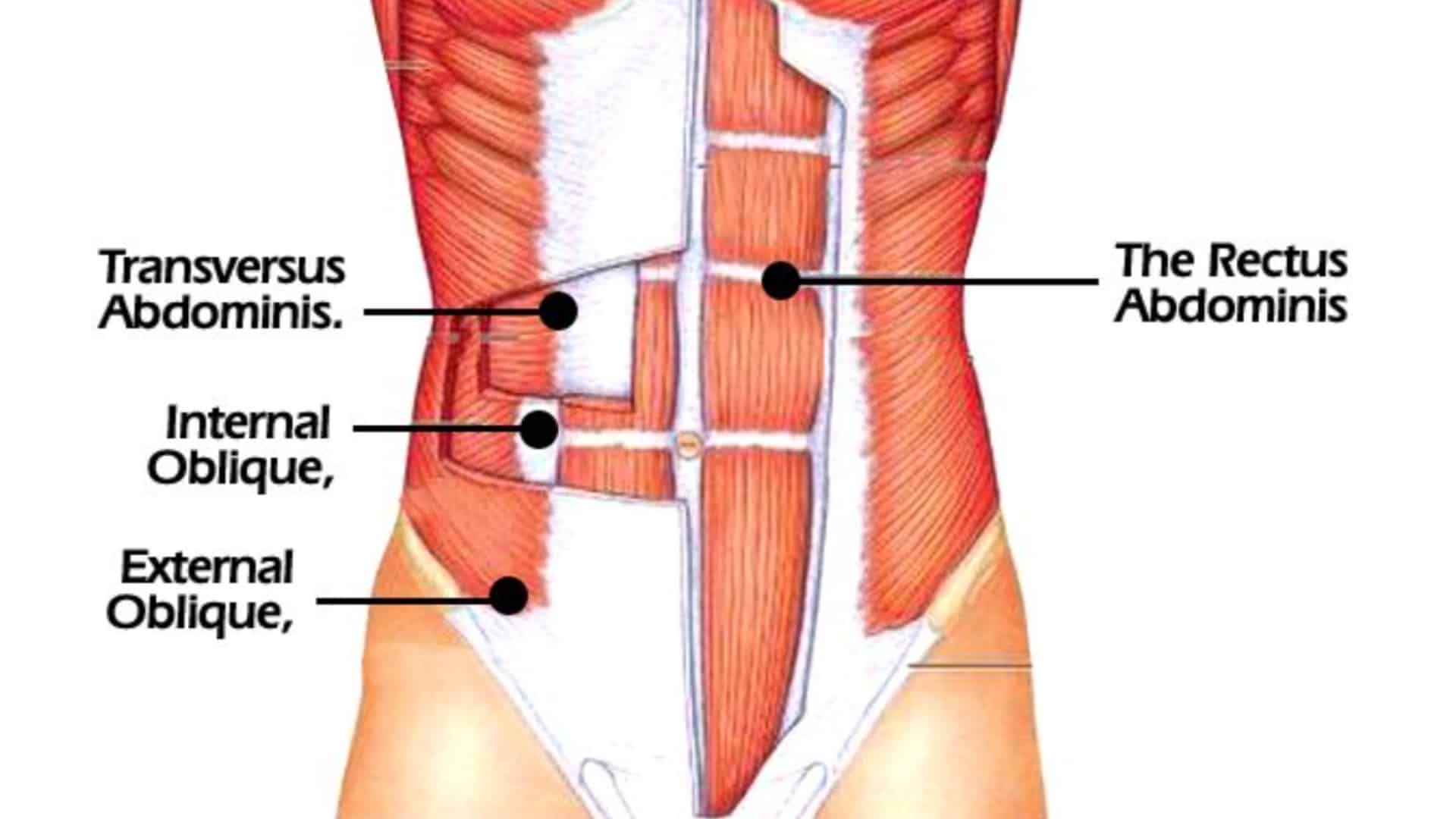
External Oblique
The external oblique is the outer visible layer that runs diagonally on each side of the rectus abdominis. It is found between the lower rib region and the pelvis.
These muscles help in side-to-side bending, spinal column flexion, torso rotation, and abdomen compression.
Internal Oblique
The internal oblique muscles lie under the external obliques and run into the lower back or erector spinae. The fibers of the two muscles pass at right angles to one another; therefore, they are often referred to as opposite-side rotators.
Transversus Abdominis
The deepest abdominal part is the transversus abdominis, which lies horizontally across the abdominal wall. The primary role of transversus abdominis is to assist with breathing, especially exhalation from the lungs. It also helps with the stabilization of the spine.
How To Train Oblique Muscles
People often think the only way to build these muscles is through side crunches or bends. However, there are many ways to strengthen and tone your obliques.
You have to look beyond conventional oblique workout routines and think creatively about how to challenge your obliques in a new way.
To effectively train your oblique muscles, follow these science-based principles and techniques:
1. Focus on Specific Oblique Exercises
Definitely, you have to perform the exercises directly engaging the obliques, such as bicycle crunches, Russian twists, side planks, and wood chop.
- The primary function of the external oblique is contralateral rotation (rotating the torso to the opposite side) and lateral flexion (bending to the side). Do Exercises like Bicycle Crunches and Russian twists to train them.
- The primary functions of the internal oblique are ipsilateral rotation (rotating the torso to the same side) and lateral flexion. Do exercises like Side Bends, Oblique Crunch, and Windshield Wipers to train it.
2. Add Rotational Exercises
To strengthen your obliques, do exercises that involve twisting or turning your body, like doing cable rotations, medicine ball twists, and landmine rotations.
These movements target both the external and internal obliques during their primary functions: torso rotation and stabilization.
3. Do Functional Movements
Functional movements are designed to replicate the demands of everyday activities, which often involve multi-plane motions (sagittal, frontal and transverse) and require core stability. Training with these exercises improves the oblique’s ability to stabilize and support the body during everyday tasks.
Include exercises that mimic real-life activities, such as farmers walk, suitcase carries, and rotational lunges.
4. Core Stability Training
Effective core training involves dynamic spine movements across various planes of motion, incorporating a full spectrum of muscle actions (eccentric, isometric, and concentric) through flexion, extension, lateral flexion, rotation, and combinations.
Exercises like planks, bird dogs, and dead bugs strengthen the core muscles, including the obliques, rectus abdominis, transverse abdominis, and lower back muscles.
5. Progressive Overload
You can gradually increase the intensity of your workouts by adding resistance and using weights, sets, and reps.
Oblique workouts focus on two main things—Intensifying and expanding.
- Intensifying means increasing resistance and reducing the rest time.
- Expanding means performing more sets and reps with varied repetitions.
6. Do Cardiovascular Exercise
Combine oblique training with cardio exercises like running, cycling, or HIIT to reduce overall body fat and reveal toned oblique muscles.
Feel free to incorporate these moves into your workout as instructed, or combine three to five of them for a powerful obliques circuit.
Use Our Calculator To Know Your Body Fat Percentage
Best Oblique Exercises For Beginners to Advance
Below, we’ve listed beginner, intermediate, and advanced routines to help you get the most out of your oblique workout. Dive in and give those “side abs” some love.
Here are 21 of the best oblique exercises you should add to your core workout routine.
- Oblique Crunches
- Dumbbell Side Bend
- Cable Side Bend
- Hanging Windshield Wiper
- Side Plank
- Twisting Sit-Up
- Bicycle Crunch
- Russian Twist
- Landmine Twists
- Side Plank with Hip Abduction
- Side Jackknife
- Lying Bent-Knee Oblique Twist
- Alternate Heel Touches
- Pallof Press
- Cable wood chop
- Cable Down-Up Twist
- Cable Twist
- Cross-Body Mountain Climber
- Bird dog
- V-Up
- Dumbbell Farmers Walk
1. Oblique Crunch
The oblique crunch is an all-time favorite and one of the best bodyweight exercises. Oblique crunches work your obliques and help strengthen your entire core, including your abs, transverse abdominus and lower back.
The best part about oblique crunches is that you don’t need any special gym equipment. You can do them right at home without any fancy gear.
Hold a weight plate on your chest to make this exercise more difficult.
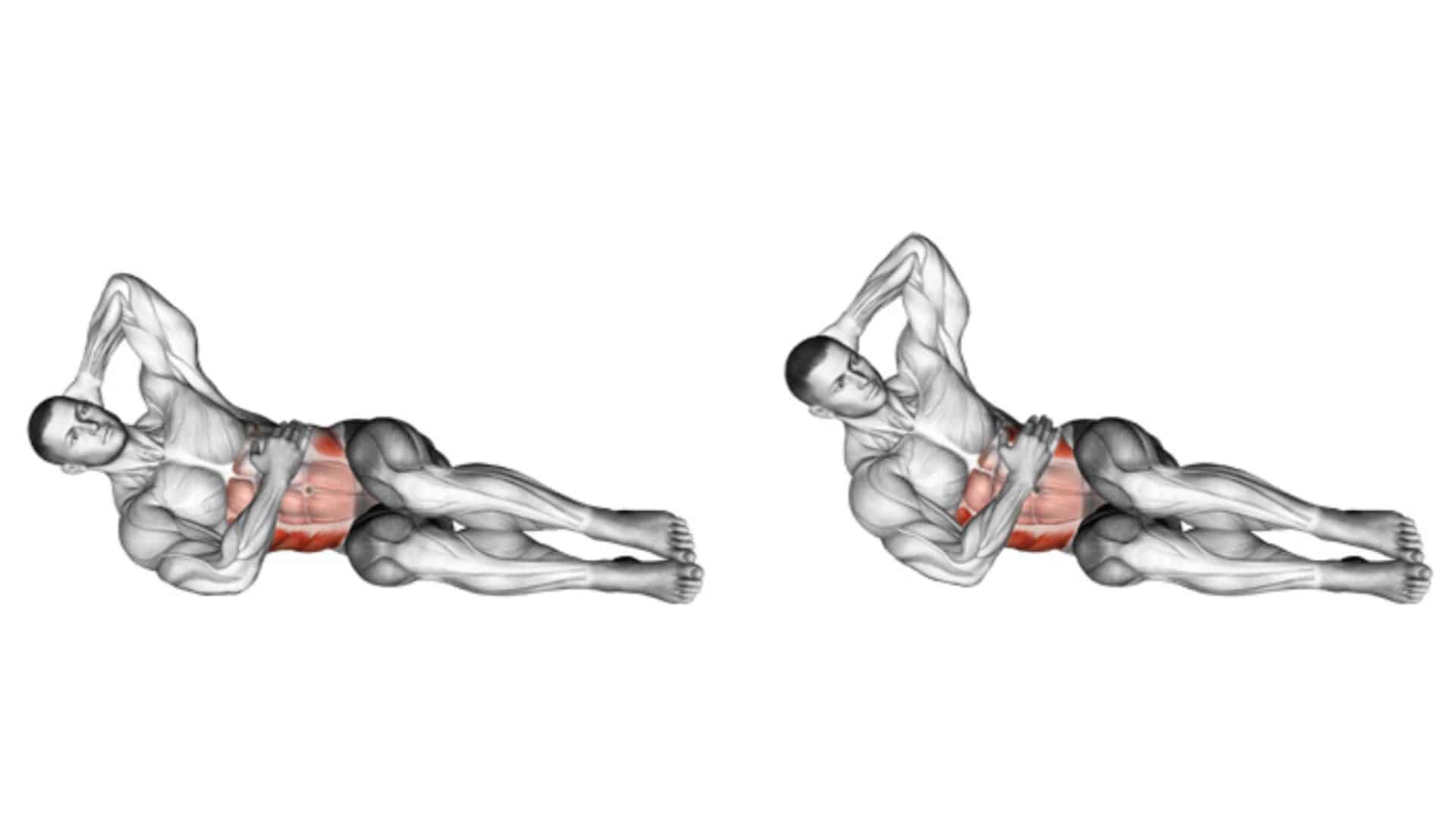
How To Do
- Lie on the floor on your right side with your hips and knees bent.
- Place your left hand behind your head and place your right hand across your body and on the obliques.
- Placing your hand on your obliques can help you feel the muscles contract and enhance the mind-muscle connection.
- Contract your obliques to lift your shoulder off the floor.
- Hold this position briefly, contracting your side as hard as possible.
- Then, return to the start position. Complete all reps on the left side and then repeat on the right.
- To work the oblique muscle, perform these exercises slowly and steadily.
2. Dumbbell Side Bend
The dumbbell side bend effectively targets the internal and external obliques, strengthens the spine’s lateral flexion, improves spinal mobility, and helps develop a strong and stable core.
- It is an easy core exercise to do at home. If you’re new to it, practice the movement with your bodyweight alone.
- Perform a kettlebell or a cable side bend for a more challenging oblique exercise variation.
- Avoid using a heavy dumbbell for this exercise. Large, overdeveloped oblique muscles will make your waist appear bulky.
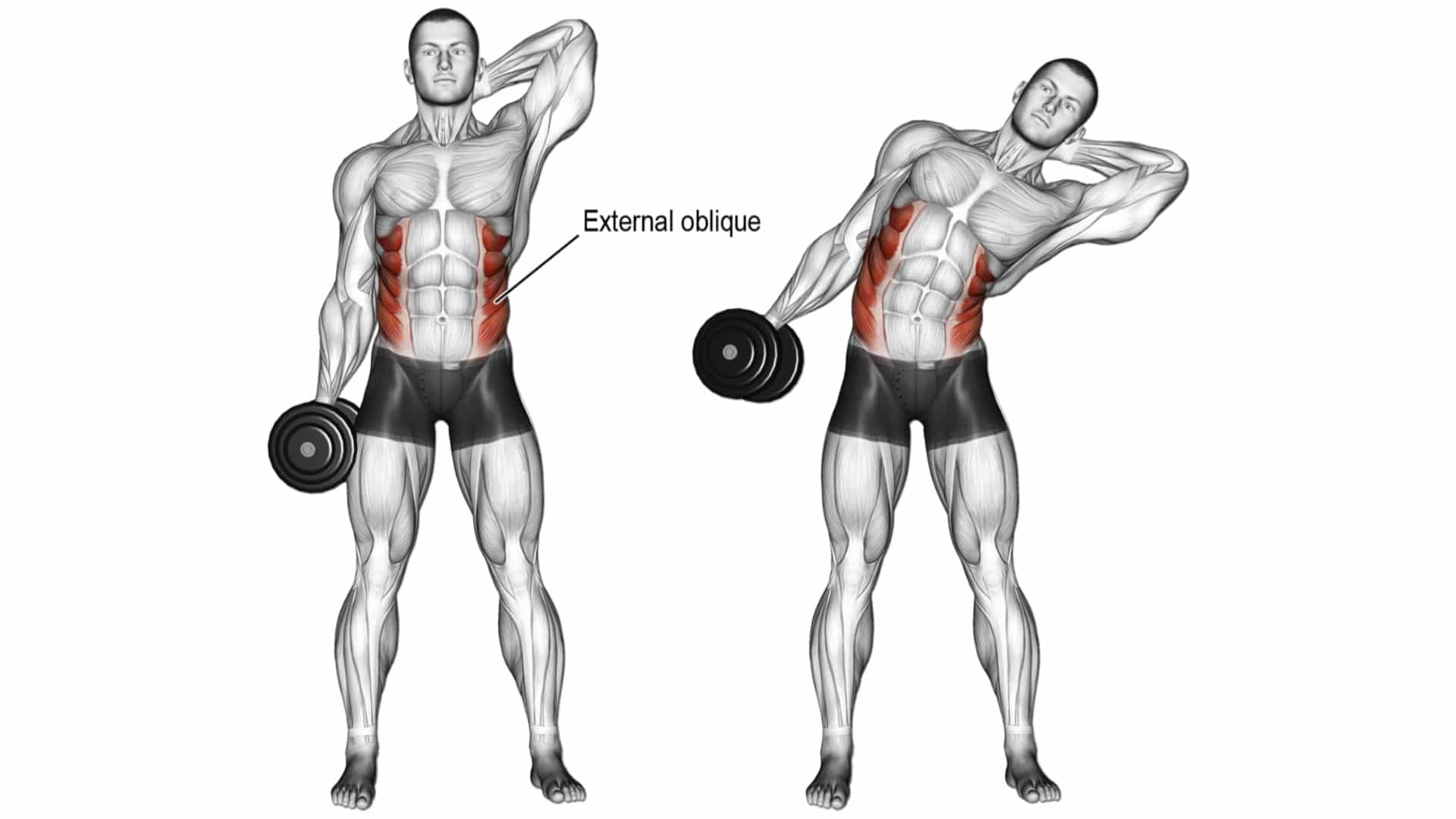
How To Do
- Hold a dumbbell in your right hand and hang your arm at your side.
- Keep the dumbbell close to your side, your elbow slightly bent, and your hips still.
- You can place your free hand behind your head.
- Bend sideways at the waist to the left as low as possible, using your oblique muscles to pull your torso down.
- Hold for a second and return to the starting position.
- Complete the desired number of reps and repeat on the other side.
Read More: How To Do Weighted Side Bends & Its Benefits
3. Cable Side Bend
The cable side bend is simply a variation of the side bend typically performed using a machine. It gives the midsection a more aesthetic appearance and helps to create the V-taper look.
One of the cool things about cable side bends is that you can adjust the resistance to make the exercise harder or easier. This means you can really challenge yourself as you get stronger

How To Do
- Attached D-handle to a low pulley and stood side-on to the weight stack.
- Grasp the D-handle with your right hand and stand with the pulley to your right side.
- Your torso should be laterally flexed (bent sideways) towards the pulley, and your arm should be straight and close to your body.
- Bend your torso away from the pulley, pulling the D-handle upward.
- Slowly lower the D-handle back to the starting position by bending your torso towards the pulley.
- Repeat for the desired number of repetitions. Turn around and repeat the cable side bend with your left side.
4. Hanging Windshield Wiper
The hanging windshield wiper is one of the most advanced oblique exercises for strengthening your core and your body’s twisting movement pattern.
This is an advanced workout, so ensure you have good grip strength, flexibility, and balance before attempting it.
The goal is to rotate the torso from one side to the other while maintaining a horizontal position. Bending your knees can make the move easier.
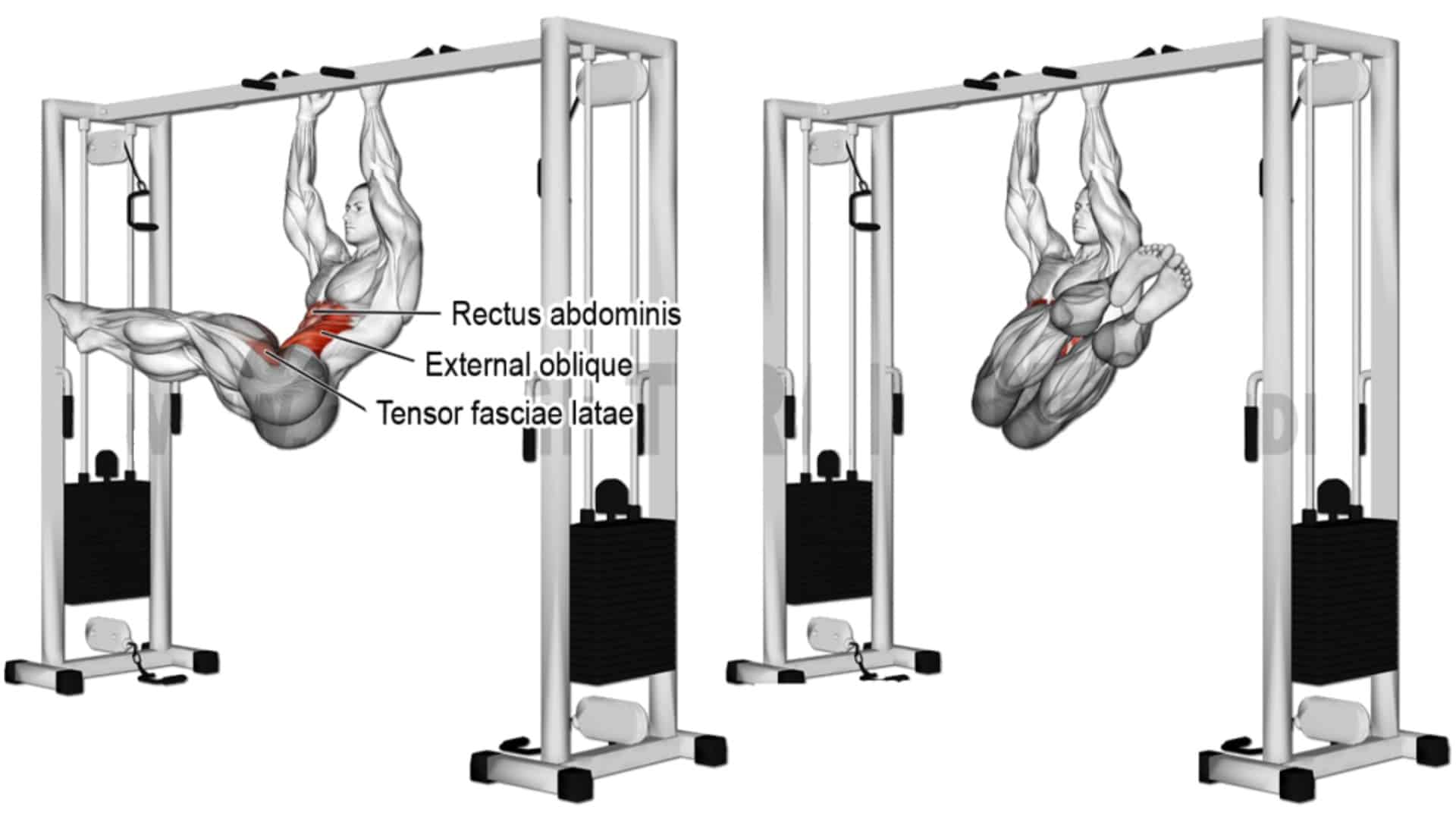
How To Do
- Grab a bar with an overhead grip, with the hands slightly wider than shoulder-width.
- Keep your core and glutes tight to keep your back and hips in the correct position.
- Lift your legs towards the bar. Keep your arms and legs straight. Your legs are perpendicular to your torso.
- Now, rotate your legs to one side until they are parallel with the floor, roughly 90 degrees.
- Slowly and with control, rotate your legs to the other side. Keep your legs as straight as possible.
5. Side Plank
The side plank (oblique plank) is one of the best core exercises for strengthening the oblique abdominal muscles, which are not worked as much during abs exercises such as crunches. It also works your shoulder and hip muscles.
Strong obliques can be quite useful as core stabilization muscles.
If you’re new to planking, you should master the basic forearm plank before moving on to the side plank variation.
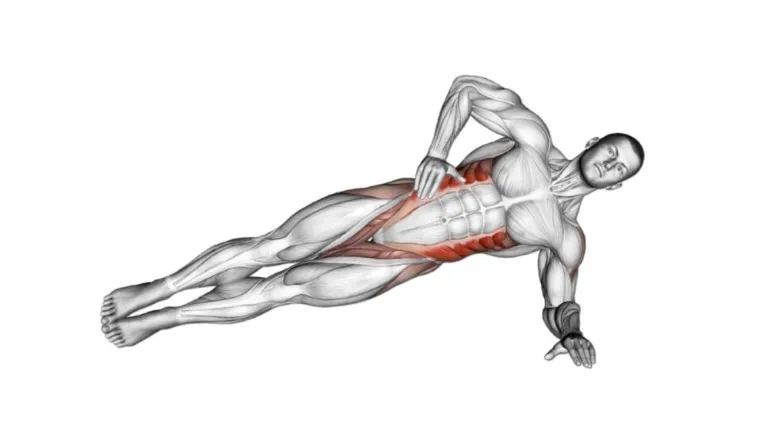
How To Do
- Get in a side plank position by lying on your right side on the floor, with your left foot resting on top of the inner side of your right foot and your left arm resting on top of your left side.
- Raise your body by placing your right forearm flat on the floor to be perpendicular to your torso.
- Lift your torso until your right upper arm is straight underneath you, with your elbow bent 90 degrees and your forearm flat on the floor.
- In this position, only your right forearm and the outer side of your right foot contact the floor, and your body forms a diagonal line at about a 20-degree angle to the floor.
- Keep your abs pulled in tight and hold this position for as long as you can, and then repeat on the left side.
6. Twisting Sit-Up
It’s a great exercise for intermediate to advanced lifters because it’s moderately challenging but very effective for its intended purpose.
Make the decline twisting sit-up easier by either crossing your arms on your chest or performing the exercise on a flat bench.
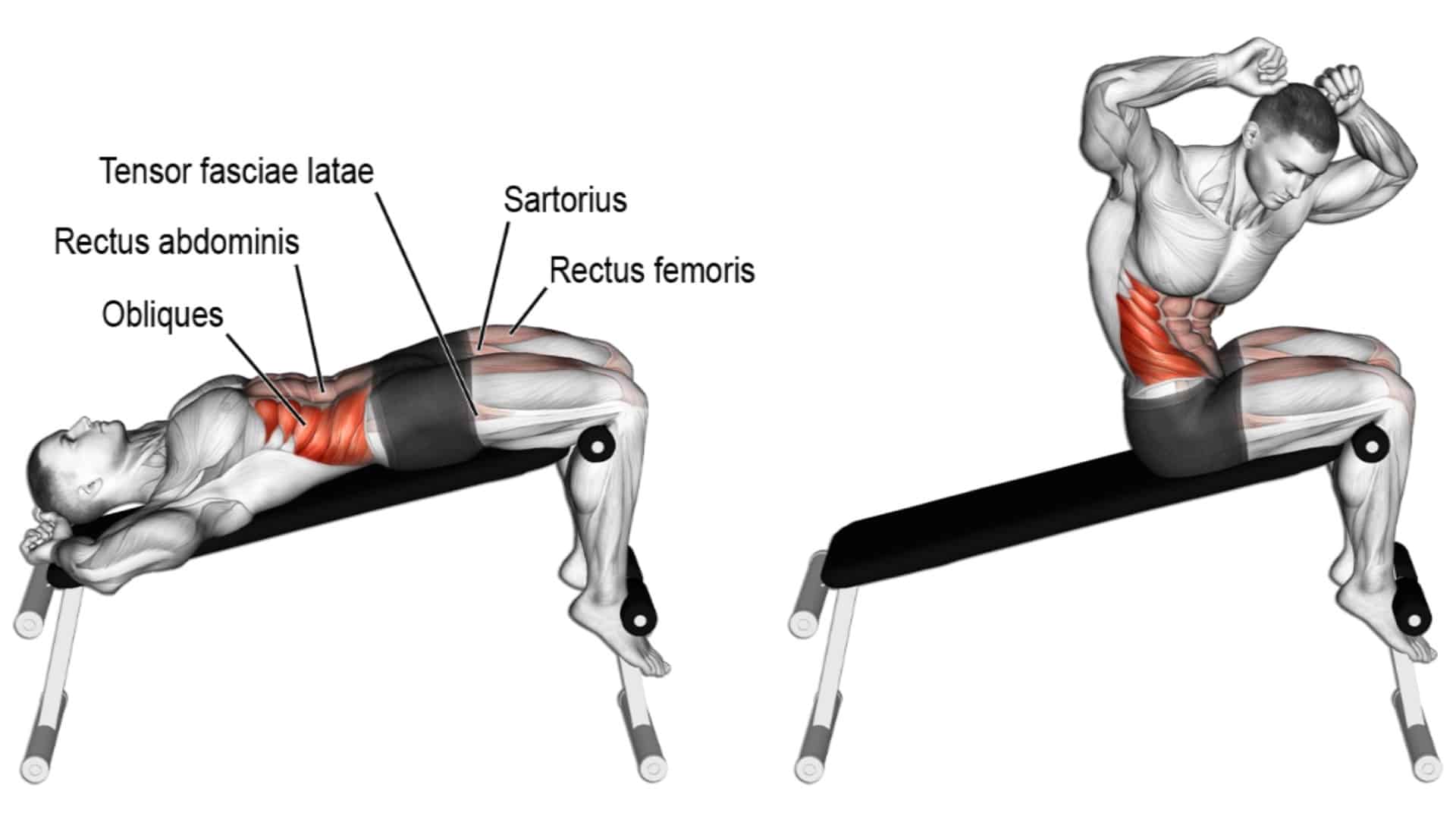
How To Do
- Sit on the decline bench, hook your feet under the pad, lean back, and position your hands behind your head.
- Keep your neck in a neutral position.
- As you sit up, twist your torso, directing your right elbow toward your left knee.
- Reverse the motion and lower your torso to the starting position; during the next repetition, direct your left elbow toward your right knee.
- Keep repeating and alternating the side to which you twist your waist.
7. Bicycle Crunch
A 2001 study by ACE found that compared to the standard crunch, the bicycle crunch produces 148% more mean activity in the abs and 190% more mean activity in the obliques.
- To make the exercise easier, you can make the angle between your knees smaller,
- To make it harder, you can make the angle between your legs bigger.
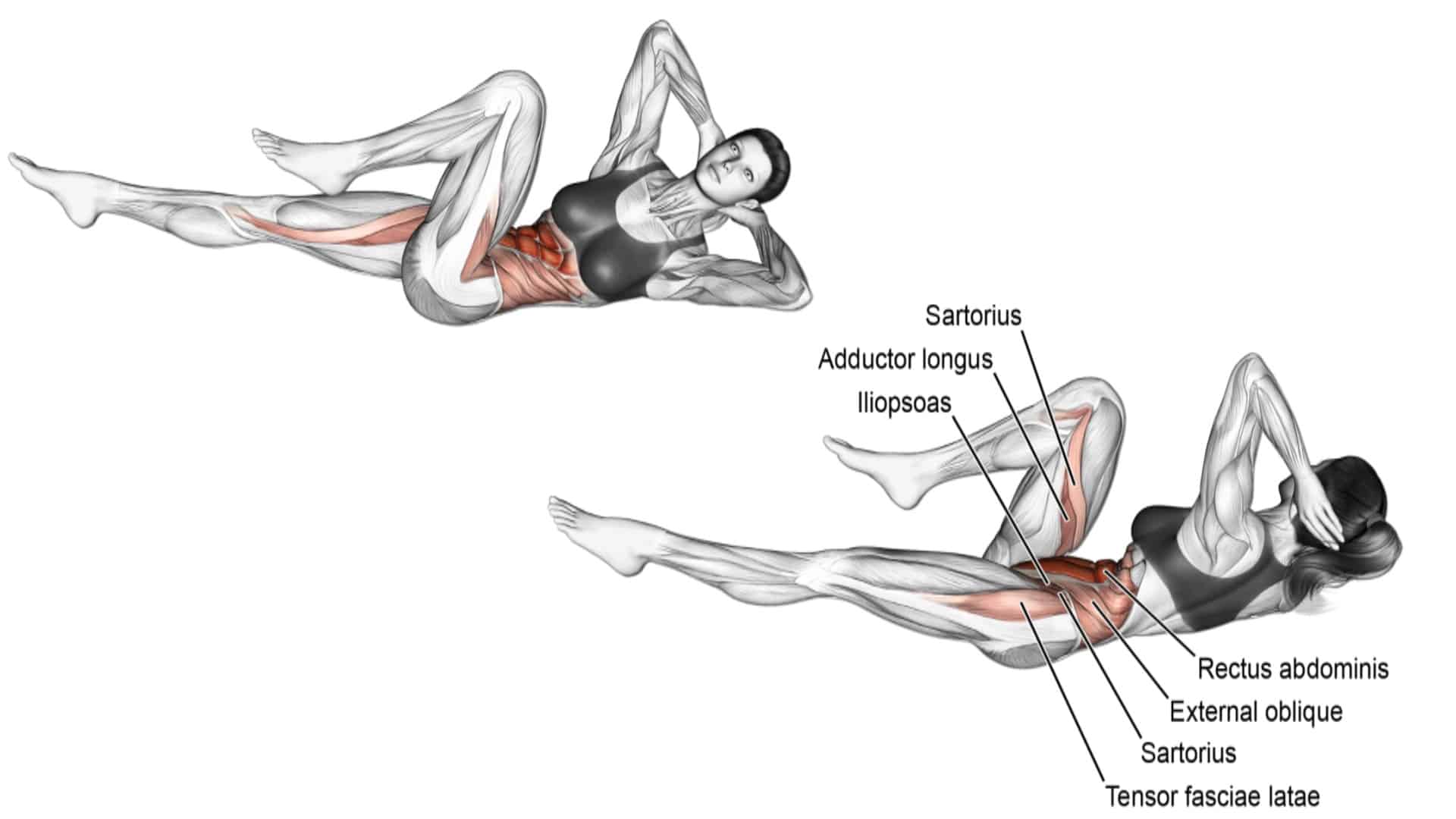
How To Do
- Lie on the floor with your legs straight and lower back flat on the floor.
- Place your hands behind your head and raise your feet and upper back a little off the floor.
- Make sure that you don’t pull your neck with your hands, else you can get a neck strain.
- Slowly start raising your knees at about a 45-degree angle.
- Go through a bicycle pedaling motion with your legs as you alternately touch your elbows to the opposite knees, twisting back and forth.
8. Russian Twist
The Russian twist engages and strengthens your core muscles and lower back. This exercise helps to tone and tighten your abs and obliques and trim your waist.
It also helps to improve your balance, stability, and posture.
A more advanced way of performing the Russian twist is to raise your feet a little off the floor and a weighted russian twist.
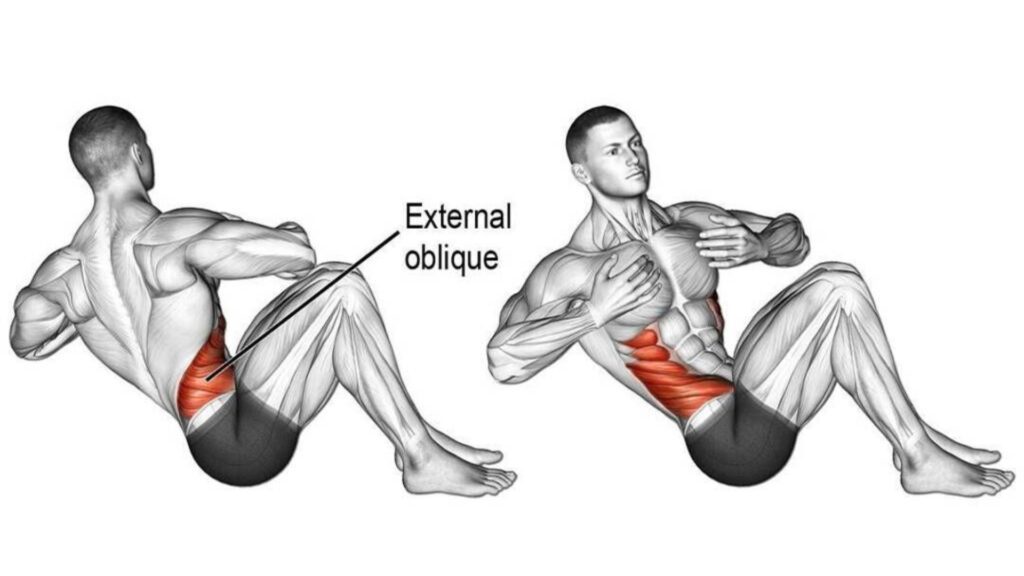
How To Do
- Lie down with your knee bent at the knees and feet flat on the ground.
- Elevate your upper body to create a V shape with your thighs.
- Begin to twist side to side while maintaining balance on your buttocks.
- Keep your back straight at all times and twist your torso only from the ribs up.
- Repeat this movement until the set is complete.
9. Landmine Twists
When you do landmine twists, you’re using your core muscles and especially your obliques and the transversus abdominis.. These muscles help with twisting and turning movements.
Landmine twists introduce unique stability and balance challenges compared to other oblique exercises. It puts less stress on your spine compared to traditional sit-ups or crunches
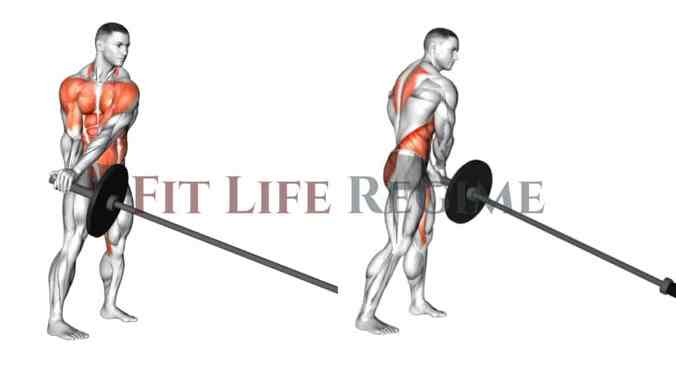
How To Do
- Position a bar into a landmine or securely anchor it in a corner. Load the bar to an appropriate weight.
- Raise the bar off the floor, taking it to shoulder height with both hands. With your arms extended in front of you, adopt a wide stance.
- Keep your knees slightly bent as you rotate. This should help relieve some tension from your lumbar spine during the movement.
- Rotate the trunk and hips as you swing the weight down to one side. Keep your arms extended throughout the exercise.
- Reverse the motion to swing the weight to the opposite side.
10. Side Plank with Hip Abduction
The side plank with hip abduction is like a two-for-one exercise. It’s a side plank that already works your core muscles and a leg lift that targets your hip muscles.
This exercise requires a lot of different muscles to work together. Your obliques (side abs), glutes (butt muscles), and hip abductors (outer thigh muscles) all have to coordinate.
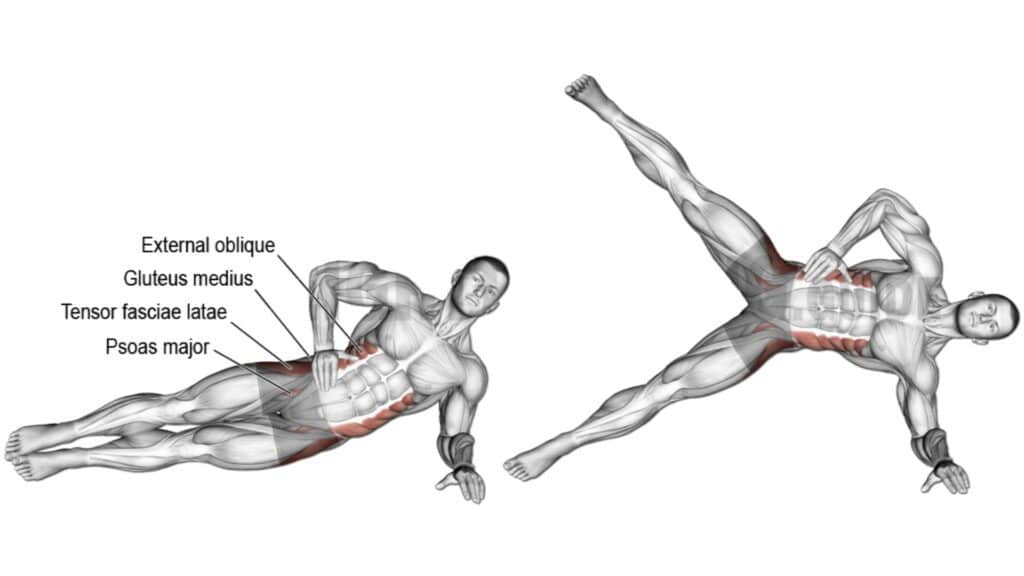
How To Do
- Lie on the floor on your left side, side with your elbow directly beneath your shoulder and legs stacked. Place your free hand on your hip.
- Straighten your body and legs. Your feet should be together, and your hip should be resting on the floor.
- Brace your abs and lift your hips off the floor until you’re balancing on your forearm and feet and your body forms a diagonal line.
- Lift your right leg at least 6 inches. Slowly bring your feet back together and lower your hip to the floor.
- Repeat on your right side.
11. Side Jackknife
The oblique V-up, also known as a side jackknife, trains the internal and external obliques, abs, thigh, and hip muscles.
Once you master the basic oblique V-up, you can increase the difficulty of the exercise by raising both legs off the ground.

How To Do
- Lie on your left hip, legs together and right leg on top of your left.
- Place your right hand behind your head and your left elbow close to your body for support.
- Use your oblique muscles to raise your top leg while simultaneously raising your torso to meet it.
- Make sure you get your upper body off the floor. Don’t just move your head.
- Hold a total contraction at the top of the movement for a count of two.
- Lower in a controlled motion and repeat, until you complete your set. Then switch sides and repeat.
12. Lying Bent-Knee Oblique Twist
Lying Bent Knee twist is one of the best bodyweight exercise that builds muscle and strength in the obliques and core.
This exercise is ideal for beginners, yoga practitioners, and anyone looking to improve their flexibility and alleviate back discomfort. It is easy to incorporate into any workout routine.
You can also do this exercise with a ball between your legs.
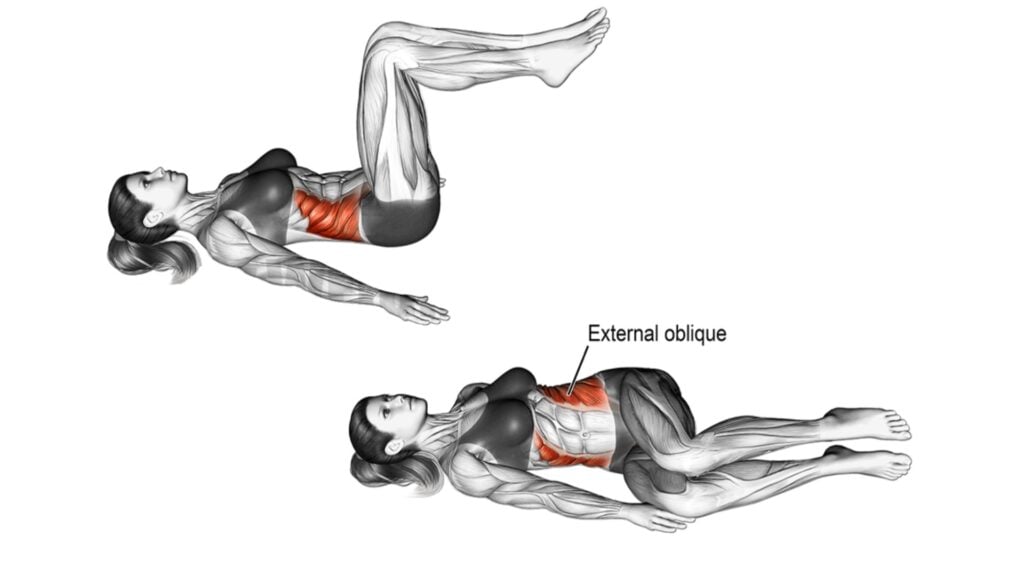
How To Do
- Lie on your back on the floor or mat with arms extended out to the sides to keep your body stable during the exercise.
- Bend your legs and raise bent legs at a 90-degree angle so your thighs are vertical and your lower legs are horizontal.
- Keep your core tight during the movement to activate your obliques against resistance.
- Keeping your shoulders in contact with the floor, slowly lower your legs to one side until you feel a mild stretch in your lower back.
- Now, rotate your legs to the right. Repeat for the desired number of reps.
13. Alternate Heel Touches
It is one of the great oblique exercises that can be done easily by beginner and advanced athletes to activate and grow their side abs.
As you alternate your reach towards each heel, your oblique muscles will contract with each touch. With each rep, you will be strengthening your entire core.
The exercise mimics other oblique exercises such as the dumbbell side bend and oblique crunch.
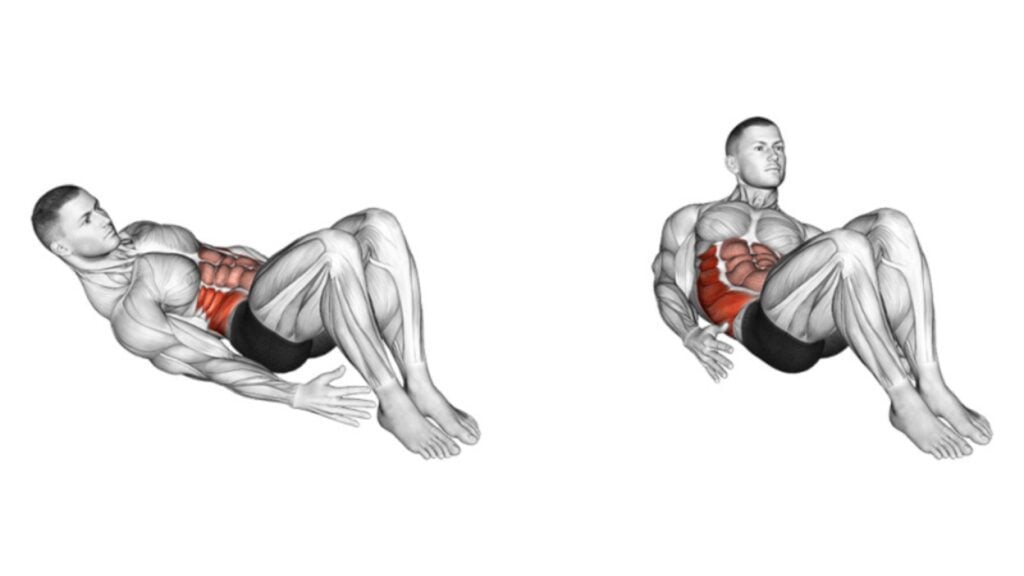
How To Do
- Lie flat on the floor, while your back and hips touch the ground.
- Bend your knees and extend your hands along your torso.
- Now, contract your abs by pulling your belly button towards your spine and crunch your torso to the right until you can touch your right heel with your right hand.
- Be sure not to strain your neck when doing any ab crunch work.
- Pause for a second and feel the stretching in your abdominal muscles.
- Come back to the starting position, touch your left hand to the left heel, and do the recommended number of repetitions every time with an alternate hand side.
14. Pallof Press
If you’re looking for a way to get more creative with your oblique workout, why not try Pallof Press?
It is a full-body exercise that can increase overall stability and activate many large muscle groups in the body.
The beauty of the Pallof press is that it challenges and strengthens the stabilization action of your abs.
It is a valuable movement prep and core strengthening exercise for nearly every lifter. It helps to establish proper spinal alignment under load and increase core stability.
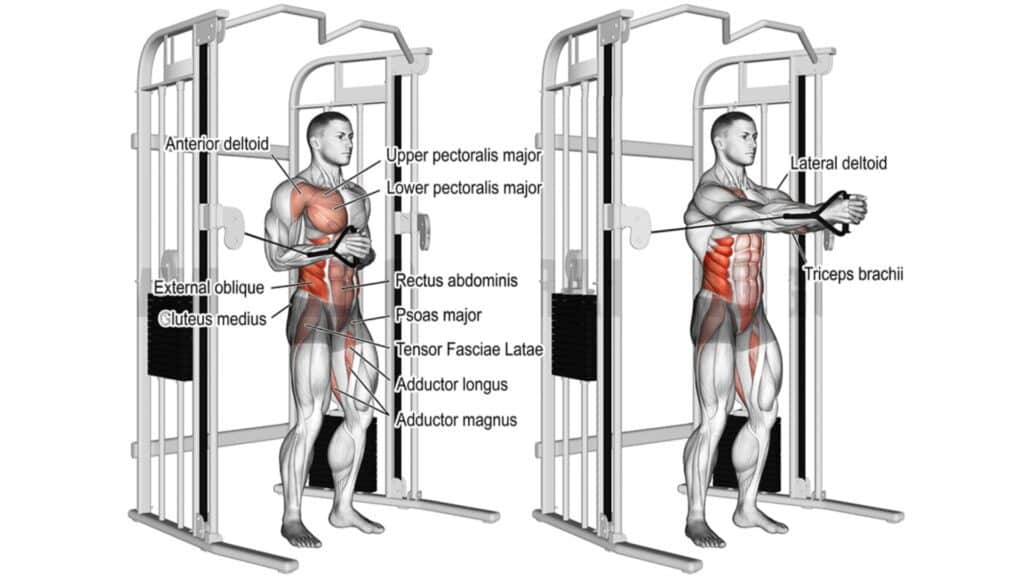
How To
- Attach a handle to a chest-high cable pulley. Stand on the side cable machine with your feet hip-width apart.
- Grasp the handle with the hand nearest the pulley, pull the handle to your chest, and place your free hand over the hand holding the handle.
- Engage your core and press the handle out with both hands, extending your arms in front of your chest.
- Hold this position, resisting the pull of the cable and not letting your torso rotate towards the machine, for five to ten seconds, then bring the handle back in to your chest.
- Repeat the exercise on your opposite side.
Read More: Most Effective Abs & Oblique Cable Exercises & Workout
15. Cable Wood Chop
The cable wood chop is also known as the cable up-down twist, you must add these oblique workouts to your oblique exercises arsenal.
This is great for strengthening the torso’s twisting movement pattern and improving its ability to resist twisting forces.
It is a compound pulling motion and a functional exercise. While it primarily targets the abs and obliques, it also employs the shoulders, back, and glutes.
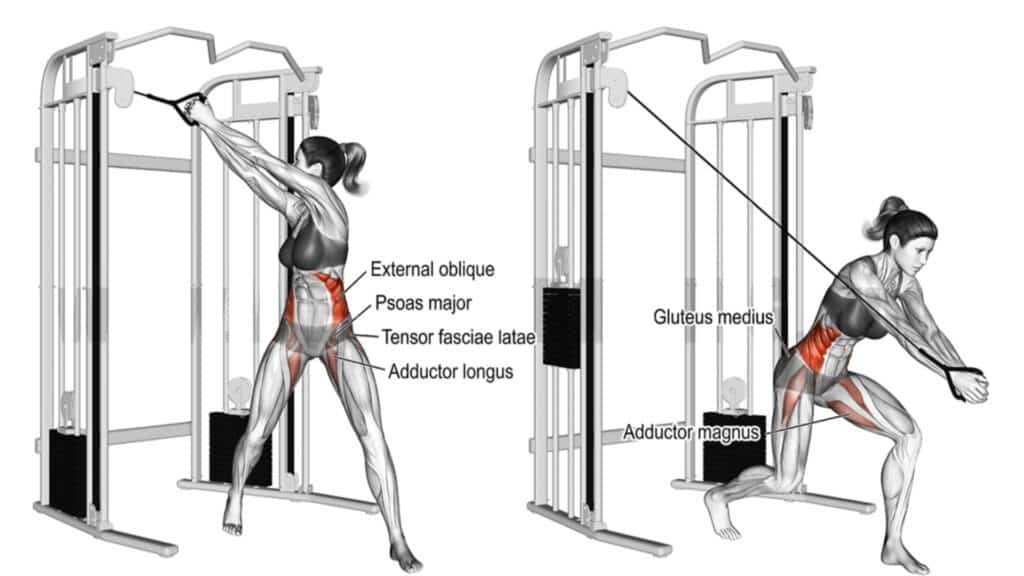
How To Do
- Attach a handle to the top of the cable pulley.
- Grasp the handle with both hands, with either your fingers interlaced or with one hand over the other.
- Stand next to the machine with your feet shoulder-width apart.
- Keeping your arms straight, pull the handle diagonally downward until your torso faces away from the pulley and your hands are knee-height.
- Don’t lock the knees and hips. Allow the hips and knees to rotate slightly.
- Hold for a count of two. Then, slowly reverse the movement to return to the starting position.
- Repeat for the prescribed number of repetitions. Repeat the exercise on your opposite side.
16. Cable Down-Up Twist
The Cable down-up twist (low-to-high Cable woodchip) is a variation of the wood chop that targets the muscles of the abdominal complex and obliques.
This is a great exercise for beginners who want to strengthen their oblique muscles and improve their core stability.

How To Do
- Attach a handle to the lowest of the cable pulley.
- Grasp the handle with both hands, either with your fingers interlaced or with one hand over the other.
- Keeping your arms straight, pull the handle in a diagonally upward motion.
- Hold for a count of two. Then slowly reverse the movement to return to the starting position.
- Repeat for the prescribed number of repetitions. Repeat the exercise on your opposite side.
17. Cable Twist
The cable twist is one of the best isolation exercises that works the oblique muscles.
It is a great idea to stop halfway through some reps, hold the stirrup, and try to resist the twisting force. This will strengthen your torso’s ability to resist twisting forces.
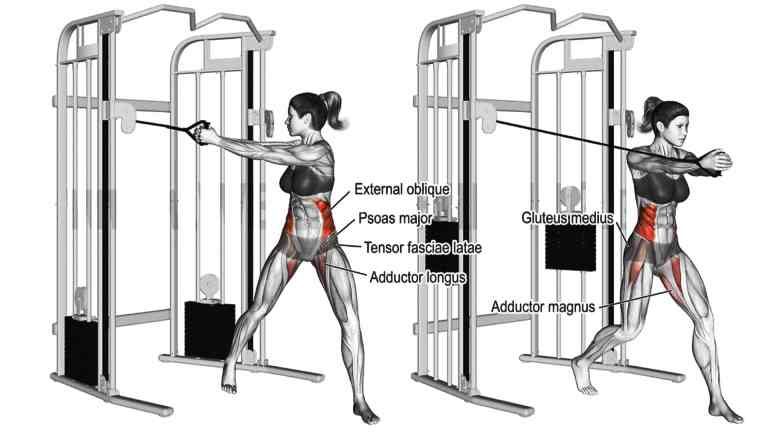
How To Do
- Attach a handle to a cable pulley that is shoulder-height. Grab the handle with both hands, either by putting your fingers together or by crossing one hand over the other.
- Move your body from one side to the other until your body is facing away from the pulley.
- Hold for two seconds and then slowly reverse the movement.
- Repeat for the prescribed number of repetitions. Repeat the exercise on your opposite side.
18. Cross-Body Mountain Climber
The cross-body mountain climber is an explosive bodyweight exercise that simultaneously engages multiple muscle groups.
It helps improve balance, agility, coordination, strength, flexibility, and blood circulation—almost like getting a total-body workout with just one exercise. This workout needs to be added to your arsenal of oblique exercises.

How To Do
- Start in the push-up position with your arms straight and directly beneath your shoulders.
- Your body should form a straight line from your shoulders to your ankles. Don’t round your lower back.
- Squeeze your abs, lift one foot off the floor and bring your left knee towards your right elbow while keeping your body in as straight of a line as possible.
- Return to the starting position and repeat the movement with your opposite leg.
19. Bird Dog
The bird-dog is a bodyweight floor exercise that strengthens the core—more specifically, the abdominal, oblique muscles, lower back, butt, and thighs.
It is a real stability exercise that ensures a stable trunk. It owes its name to the position, alternating between sitting on hands and knees (dog) and stretching the arms and legs (bird).
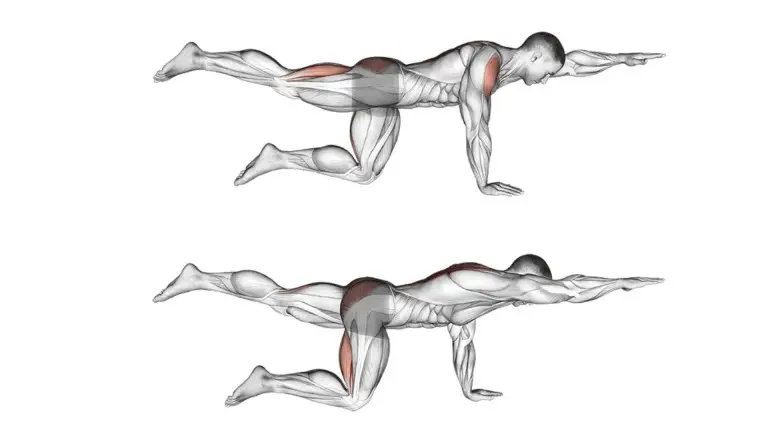
How To Do
- Get on your knees and place your hands on the floor in front of your body at shoulder width.
- Keep your spine in a neutral position, contract your abs, and lift one hand and the opposite knee slightly off the floor.
- Now, extend your arm and leg out. Try to form a straight plane from your hand to your foot.
- Hold this position for about 10 seconds and then return to the starting position.
- Repeat the exercise with the other side.
20. V-Up
The V-Up, also known as a jackknife, is a full-body move. This exercise is designed to burn out the obliques and abs, including the upper and lower abs muscles, simultaneously.
The V-up is an advanced core exercise. To make it more difficult, hold a weight plate or medicine ball in your hands and wear a pair of ankle weights while you perform the standard V-up.
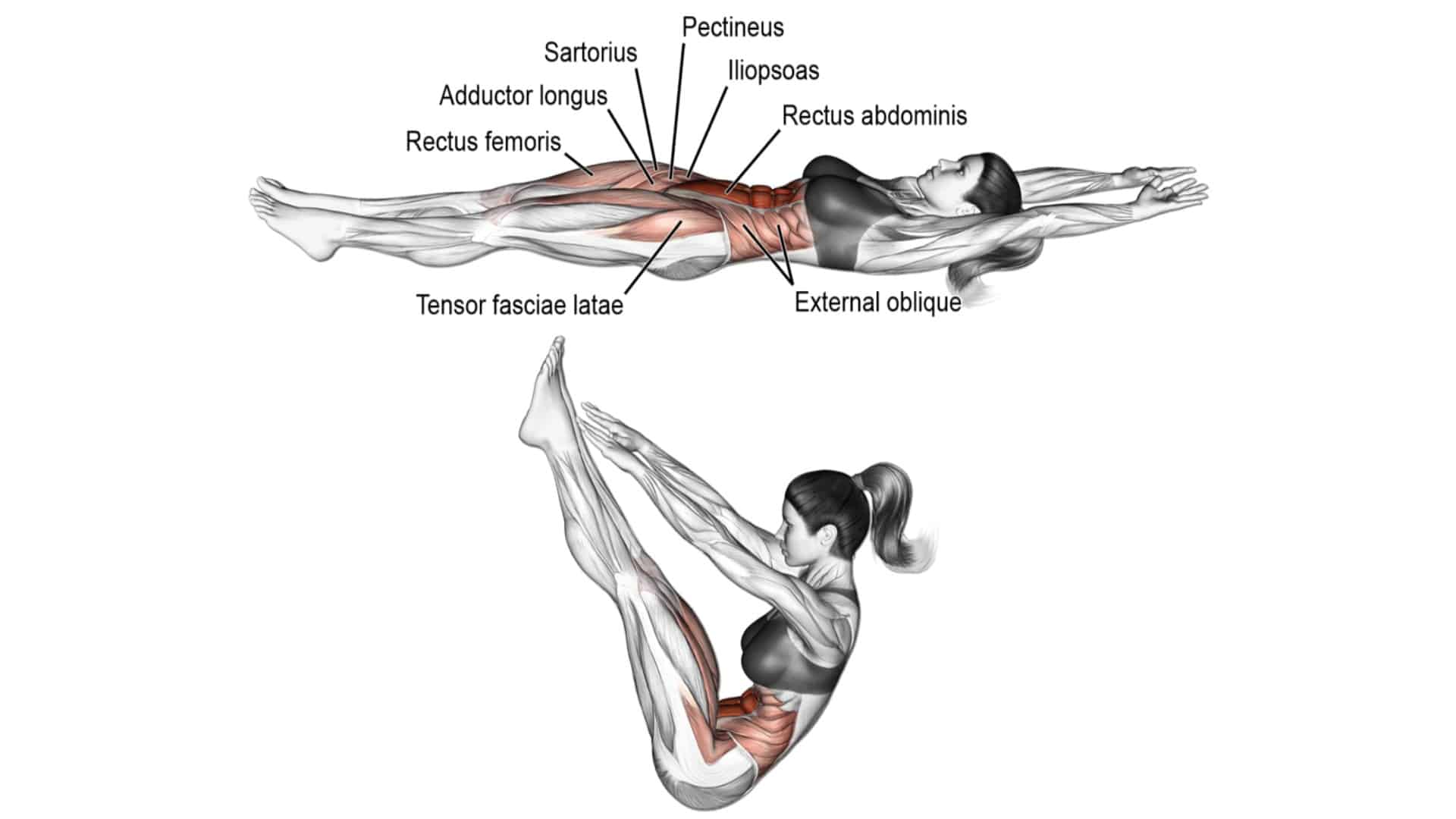
How To Do
- Lie down on the floor on your back with your arms extended straight back behind your head. Your legs should also be extended.
- Exhale and bend at your waist while raising your legs and arms to meet in a jackknife movement. Try to hold the contracted position.
- Lower your arms and legs back to the starting position and inhale as you do so.
- Try to keep your back as straight as you can during the V-up.
21. Dumbbell Farmers Walk
Finally, try the dumbbell farmer’s walk if you’re looking for one more effective oblique exercise. It is a great exercise for improving grip strength and building abdominal and oblique muscles.
It also improves your overall strength and functional fitness by strengthening your core, back, glutes, legs, and gait.
The farmer’s walk exercise also called the farmer’s carry, is a strength and conditioning exercise in which you hold a heavy load in each hand while walking for a designated distance.
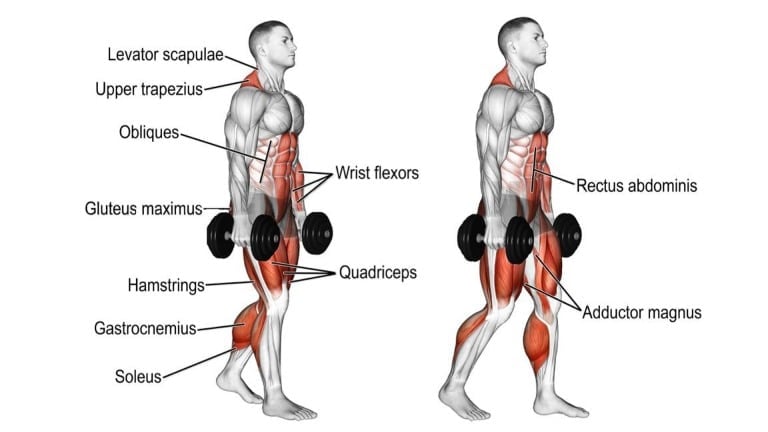
How To Do
- Deadlift a pair of dumbbells from the floor.
- Reach down, bending at the hips and knees, and grasp the dumbbells in each hand.
- Hold the dumbbells at your side with a firm grip. Stand tall, keeping your shoulders, back, and core tight.
- Take small steps and walk forward at an even pace with your eyes focused straight ahead of you.
- Complete the desired number of steps, stop, and place the dumbbells down while keeping a tight core and neutral spine.
Common Misconceptions About Oblique Exercises
Many people avoid including oblique exercises in their workout routines because of misconceptions. Let’s address these misconceptions and clarify the truth.
1. Oblique exercises will make my waistline wider
Many women worry that working their oblique muscles will make their waist look bigger. However, this is far from the truth. While oblique exercises can build muscle, they do not cause significant muscle hypertrophy. Instead, they help tone and define your waistline, giving you a more sculpted appearance.
2. Oblique workout is only for advanced
Another misconception is that oblique workouts are only for experienced fitness enthusiasts. In reality, numerous beginner-friendly oblique exercises can be modified to suit any fitness level.
3. Oblique exercises are only for aesthetics
While oblique exercises can help you achieve a more defined waistline, their benefits go beyond aesthetics. Strengthening your oblique muscles improves your overall core strength, improves your athletic performance, and reduces the risk of lower back pain.
So, don’t consider these exercises just cosmetic; they also have many other benefits.
Complete Oblique Workout Plans
If you want to create a balanced abs workout, add two or three oblique exercises to each routine.
Sets And Reps
Of course, the number of sets and reps will be determined based on your fitness journey, but here is a great starting point:
- Beginners: ~10 sets per week.
- Intermediate: ~15 sets per week.
- Advanced: ~20 sets per week.
When a certain amount of volume stops being effective and your progress stalls, you can add sets to increase volume and use that as a driver of renewed progress.
The best rep ranges and loads to work with.
- 10-12 reps with a moderate load
- 15-20 Bodyweight
Beginner Oblique Workout Plan
If you are a beginner or new to the task, do not worry. This beginner-friendly oblique workout routine is a great place to start.
When this gets easy, choose a free weight. When you feel strong in the movements below, move on to the intermediate routine. Until then, you can follow this.
| Plan 1 | Sets | Reps/Duration | Rest |
|---|---|---|---|
| Oblique Crunches | 4 | 10-15 reps | 60-90 sec |
| Side Plank | 3 | 30-60 sec hold | 60-90 sec |
| Russian Twist | 3 | 8-10 reps | 60-90 sec |
| Plan 2 | Sets | Reps/Duration | Rest |
|---|---|---|---|
| Alternate Heel Touch | 3 | 12-15 reps | 45-60 sec |
| Side Jackknife | 4 | 8-12 reps | 45-60 sec |
| Lying Bent-Knee Twist | 3 | 10-12 reps | 45-60 sec |
Intermediate Oblique Workout Plan
If you are at the intermediate level or have outgrown the beginner routine, try the intermediate oblique workout routine below.
| Plan 1 | Sets | Reps/Duration | Rest |
|---|---|---|---|
| Twisting Sit-Up | 4 | 8-10 reps | 45-60 sec |
| Cable Wood Chop | 4 | 8-12 reps | 45-60 sec |
| Dumbbell Side Bend | 3 | 8-10 reps | 30-45 sec |
| V-Up | 3 | 12-15 reps | 30-45 sec |
| Plan 2 | Sets | Reps/Duration | Rest |
|---|---|---|---|
| Pallof Press | 3 | 8-10 reps | 45-60 sec |
| Bicycle Crunch | 4 | 8-10 reps | 45-60 sec |
| Dumbbell Side Bend | 3 | 10-12 reps | 30-45 sec |
| Cross-Body Mountain Climber | 3 | 12-15 reps | 30-45 sec |
Advanced Oblique Workout Plan
If you are an advanced-level athlete or have already completed the beginner and intermediate oblique workouts, try the advanced routine.
Here, you’ll challenge your balance, stability, and strength more.
- Cable Side Bend: 3 sets of 8-10 reps.
- Hanging Windshield Wiper: 4 sets of 8-10 reps.
- Pallof Press: 3 sets of 8-12 reps.
- Side Plank With Hip Abduction: 3 sets and 60-90 sec hold.
Frequently Asked Question
Do oblique workouts slim your waist?
Only an oblique workout won’t slim your waist size. Fat doesn’t convert to muscle, so performing oblique exercises alone will not result in a reduced waistline. But oblique exercises along with Consistent cardio will most likely yield the most successful fat loss, resulting in a slimmer waistline.
How can I tone my obliques fast?
Choose 3-4 exercises from the mentioned above list and do 3-4 sets of each to tone your oblique muscle. And remember, you should never train oblique muscles more than 3 times per week.
Do lower reps if you’re incorporating heavy weight with some of the moves. It is advisable to modify the workout according to intensity and duration.
How do you lose oblique fat?
To lose the extra subcutaneous fat around your waist, lift three times per week, including moves such as squats, deadlifts, chest presses, and rows. Use a weight that makes eight to ten repetitions feel hard. Work up to three sets of each exercise. Also, add cardio exercises to your workout regime.
You should also limit sugary foods and make 25 to 30 percent of your daily calories from sugar. To lose oblique fat, you should limit the amount of sugar you eat, reduce the number of calories you consume from sugar, and eat healthy fat.
Can I target my obliques without using any equipment?
Yes, many effective oblique exercises, such as bicycle crunches, side planks, and standing side bends, can be performed without equipment.
Can I train obliques every day?
No, it is not recommended to train obliques every day. Training them every other day or 2-3 times a week is usually enough to build and recover muscles.
Takeaways
An oblique exercise can be used for beginners or advanced exercisers. There are too many benefits of strengthening these muscles to pass up. So start exercising—and specifically, crunching, bending, and rotating, as well as planks.
A balanced workout routine should include a variety of different exercises that target different muscles. This will help prevent overuse injuries by preventing your body from getting used to the same daily routine.
An oblique workout routine can effectively strengthen these muscles without sacrificing the strength of any other part of your body.
Thank you for reading, and enjoy your workout.

Manish brings over 10 years of hands-on experience in weight lifting and fat loss to fitness coaching. He specializes in gym-based training and has a lot of knowledge about exercise, lifting technique, biomechanics, and more.
Through “Fit Life Regime,” he generously shares the insights he’s gained over a decade in the field. His goal is to equip others with the knowledge to start their own fitness journey.
